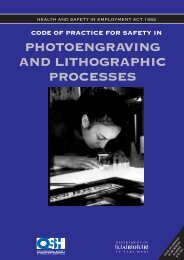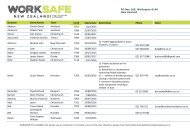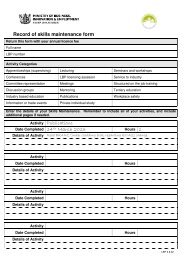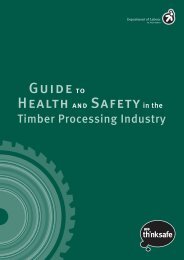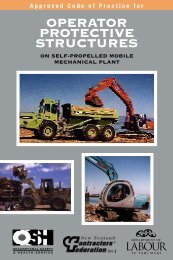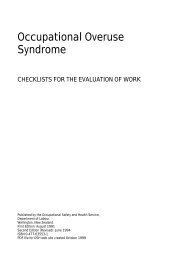Formaldehyde WES 2010 [143 KB PDF] - Business.govt.nz
Formaldehyde WES 2010 [143 KB PDF] - Business.govt.nz
Formaldehyde WES 2010 [143 KB PDF] - Business.govt.nz
You also want an ePaper? Increase the reach of your titles
YUMPU automatically turns print PDFs into web optimized ePapers that Google loves.
INFORMATION SHEET<br />
formaldehyde workplace exposure standard<br />
PLA 11590.2 DEC 10<br />
In December <strong>2010</strong>, the Department of Labour made changes<br />
to the Workplace Exposure Standard (<strong>WES</strong>) for formaldehyde.<br />
The existing <strong>WES</strong> for formaldehyde is:<br />
• Ceiling 1ppm<br />
Two new <strong>WES</strong> for formaldehyde apply in addition to the<br />
existing <strong>WES</strong>-Ceiling:<br />
• 0.5ppm <strong>WES</strong>-TWA (eight hour shifts)<br />
• 0.33ppm <strong>WES</strong>-TWA (12 hour shifts)<br />
The new <strong>WES</strong> will be implemented over a one-year period,<br />
commencing 13th December <strong>2010</strong>. This means that employers<br />
and people in charge of workplaces have one year to make any<br />
changes necessary to ensure that no person is exposed to a<br />
concentration of formaldehyde exceeding the <strong>WES</strong>.<br />
At this stage, these <strong>WES</strong> are guideline values until the<br />
Environmental Risk Management Authority has formally<br />
adopted them as controls under the Hazardous Substances<br />
and New Organisms Act 1996. At this point, the Authority will<br />
determine whether or not the <strong>WES</strong> should be guidelines only.<br />
What is a Workplace Exposure Standard?<br />
There are, in fact, a number of Workplace Exposure<br />
Standards (<strong>WES</strong>), designed for exposures over various time<br />
periods. In assigning the <strong>WES</strong>, defining a level that will achieve<br />
freedom from adverse effects is the major consideration.<br />
In the case of formaldehyde, we use the following values:<br />
1. Time Weighted Average (TWA) – this means an average<br />
exposure of up to 0.5ppm (parts per million) formaldehyde<br />
over an eight-hour work day, or 0.33ppm over a 12-hour<br />
work day is permissible without experiencing poor health<br />
effects.<br />
2. Ceiling – the formaldehyde concentration should never<br />
exceed 1ppm during any part of the working day.<br />
How are <strong>WES</strong> used in the workplace?<br />
<strong>WES</strong> are used in relation to monitoring hazardous substances<br />
in the workplace environment. Special monitoring equipment<br />
is needed to measure airborne substances in the workplace<br />
(called air sampling). The equipment can cost a lot of money,<br />
and you need specialist training in how to take representative<br />
samples and make a correct analysis. In most workplaces, air<br />
sampling is carried out by occupational hygienists or people<br />
with similar qualifications and experience.<br />
In all instances <strong>WES</strong> relate to exposure that has been<br />
measured by personal monitoring that uses methods that<br />
gather air samples from the workers’ breathing zones. The<br />
objective of personal monitoring is to assess the air a worker<br />
is breathing, as it is the workers’ exposure that the <strong>WES</strong> is<br />
concerned with.<br />
Section 11 of the Health and Safety in Employment Act 1992<br />
requires employers to provide the monitoring results to the<br />
workers concerned.<br />
Why did the Department of Labour change the <strong>WES</strong> for<br />
formaldehyde?<br />
The formaldehyde <strong>WES</strong>-TWA was added because:<br />
• It is difficult to measure peak formaldehyde exposures using<br />
sampling methods commonly used in New Zealand, and<br />
• the Ceiling limit effectively allowed a time-weighted<br />
average exposure of up to 0.99ppm over an eight-hour<br />
period. The current research shows that this level would<br />
not be an acceptable exposure over this period of time.<br />
The addition of the TWAs means that more may have to be<br />
done in the workplace to reduce the level of worker exposure<br />
to this substance.<br />
What are the health effects of formaldehyde<br />
exposure?<br />
<strong>Formaldehyde</strong> can cause acute (short term) and chronic (long<br />
term) health effects. Acute effects may include sensory<br />
irritation of the eyes, nose and throat.<br />
<strong>Formaldehyde</strong> is a skin irritant and a strong skin sensitiser.<br />
This means that once a person is sensitised, further exposure<br />
may cause intense responses, even at low concentrations.<br />
Long term (chronic) exposure to formaldehyde may result in<br />
changes to the cells it regularly comes into contact with, such<br />
as inside the nose.<br />
<strong>Formaldehyde</strong> is classified as a confirmed carcinogen, or<br />
cancer-causing agent, in New Zealand.<br />
What occupations are linked to formaldehyde<br />
exposure?<br />
<strong>Formaldehyde</strong> occurs naturally in the environment, and it is<br />
also produced (in low levels) in the body during metabolism. It<br />
is also produced during combustion.<br />
Occupationally, people are usually exposed to formaldehyde by<br />
breathing in formaldehyde vapours, although formaldehyde is<br />
also present in formalin, a liquid preservative.<br />
<strong>Formaldehyde</strong> is likely to be used in the following occupations:<br />
• Laboratory work<br />
• Mortuaries and funeral homes<br />
• Urea-formaldehyde insulation production<br />
• Pressed wood products including panel and board<br />
manufacturing<br />
• Resin manufacturing
• Isocyanate paint and printing ink manufacturing<br />
• Mould product casting<br />
• Medical preservatives<br />
• Motor vehicle manufacturing<br />
• Textile manufacturing<br />
• Natural gas and petroleum production.<br />
What can be done to lower the amount of hazardous<br />
substances in the workplace air?<br />
There are a number of ways to lower hazardous substances in<br />
the air, but it depends on a number of factors, including the<br />
work process, the equipment used and the work environment.<br />
Here are some general examples of what could be done to<br />
lower worker exposure to hazardous substances:<br />
• Substitute the hazardous substance for a less hazardous<br />
product;<br />
• Install extraction ventilation to take the air containing the<br />
hazardous substance away from the workers;<br />
• Enclose manufacturing processes so that all of the work<br />
involving the hazardous substance is conducted in a separate<br />
room or chamber that no-one normally works in; and<br />
• ONLY as a last resort; or as an interim measure while<br />
long-term solutions are introduced: use personal<br />
protective clothing and equipment (PPE) to further<br />
reduce worker exposure.<br />
Why can’t we just rely on PPE to protect us from harm?<br />
The Health and Safety in Employment Act 1992 places duties<br />
on employers to eliminate all significant hazards in the<br />
workplace to ensure the safest working environment.<br />
But in a lot of cases, we need to work with certain machines,<br />
chemicals and hazardous processes in order to get the job<br />
done. If the hazards cannot be eliminated, the employer is<br />
required to isolate the hazards from the workers.<br />
Eliminating and isolating hazards can be initially expensive, and<br />
can take some time to develop. But they are the preferred<br />
method of hazard management, and make good business<br />
sense in the long term.<br />
If some hazards cannot be eliminated or isolated, the employer<br />
must minimise employee exposure. Minimisation may include<br />
extraction ventilation, job rotation and using PPE.<br />
Personal protective clothing and equipment may seem like<br />
the cheapest way to solve a hazardous substance exposure<br />
problem, but in most cases, it ends up costing the employer<br />
more money, and may place the worker at risk.<br />
Common respiratory protection does not provide 100%<br />
protection against the substance.<br />
Other issues with relying upon PPE as the sole means of safety<br />
management include:<br />
• Poorly maintained PPE (e.g. holes in gloves, unchanged<br />
mask filters) increases worker exposure<br />
• People sometimes forget to wear the PPE<br />
• People can find it uncomfortable to wear the PPE and<br />
may take the risk of removing it in a hazardous work<br />
environment<br />
• Consumable PPE can cost a lot of money to replace if<br />
being used as a long-term or permanent control<br />
• The PPE may not provide protection against a large surge<br />
of a hazardous substance in the event of an accident<br />
• The workplace environment has to be regularly monitored<br />
to check that hazardous substances are still within safe<br />
levels.<br />
In your workplace, the principles for dealing with hazardous<br />
substance exposure must be to:<br />
ELIMINATE, ISOLATE, MINIMISE.<br />
Further sources of information:<br />
• Workplace Exposure Standards effective from <strong>2010</strong><br />
• The Approved Code of Practice for the Management of<br />
Substances Hazardous to Health in a Place of Work<br />
Contact the Department of Labour on 0800 20 90 20<br />
or visit www.dol.<strong>govt</strong>.<strong>nz</strong>.<br />
The Department of Labour takes no responsibility for the results of any<br />
actions taken on the basis of this information, or for any errors or omissions.<br />
www.dol.<strong>govt</strong>.<strong>nz</strong> 0800 20 90 20


![Formaldehyde WES 2010 [143 KB PDF] - Business.govt.nz](https://img.yumpu.com/38358753/1/500x640/formaldehyde-wes-2010-143-kb-pdf-businessgovtnz.jpg)

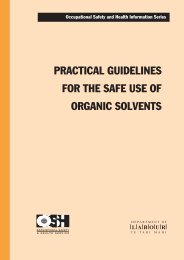
![Task analysis worksheet [161 KB PDF] - Business.govt.nz](https://img.yumpu.com/51400981/1/190x135/task-analysis-worksheet-161-kb-pdf-businessgovtnz.jpg?quality=85)

